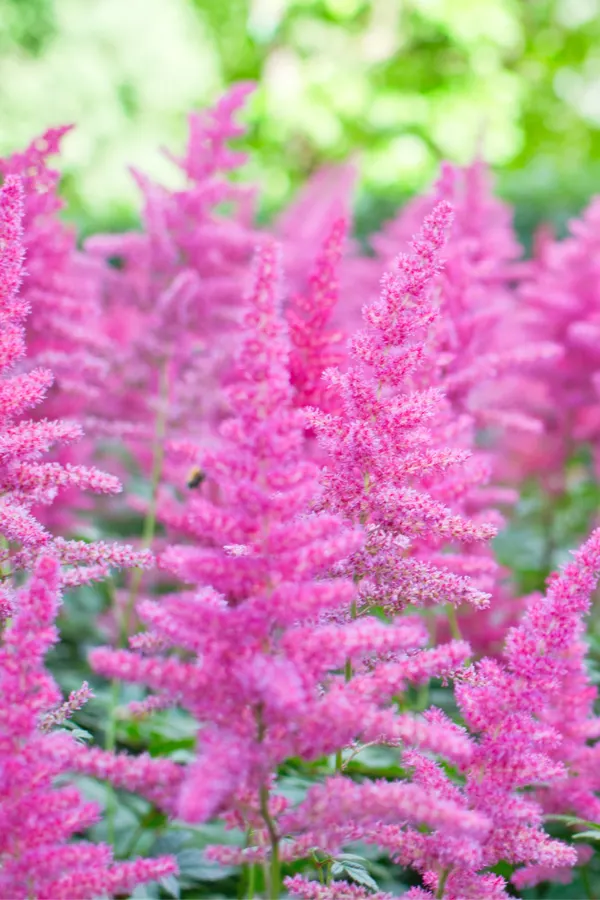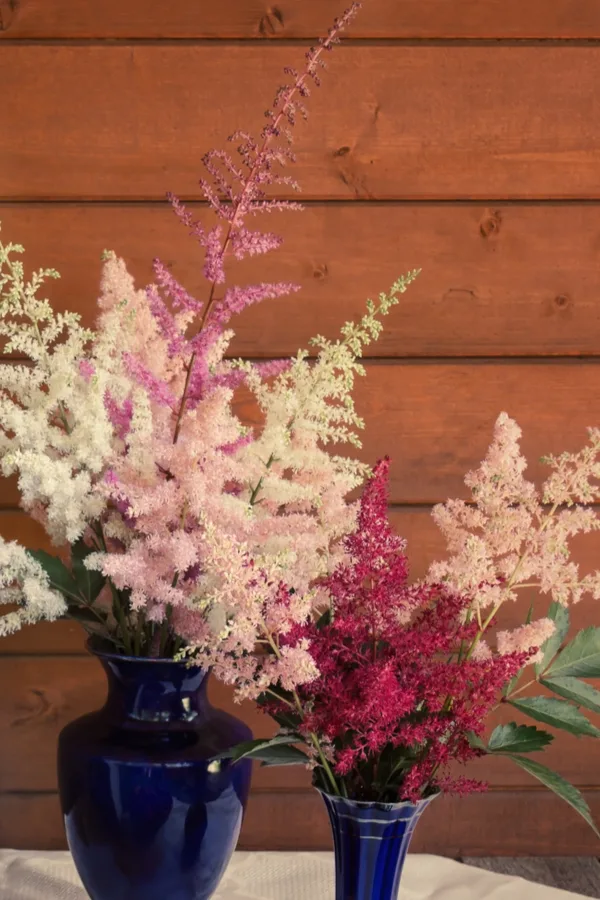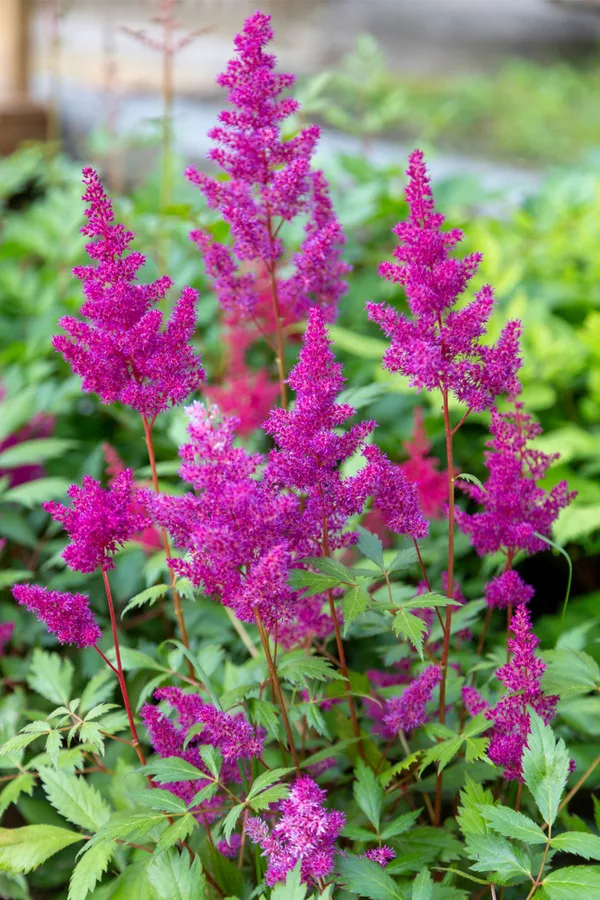Astilbe is a wonderful choice for planting in the shadier areas of a landscape that might not receive enough sunlight to successfully grow many of the other “showier” perennials.
Not only will its shiny foliage add big interest from early spring until late fall, the beautiful clusters of blooms in red, white or pink are perfect for bringing intense color to your flowerbeds. And if that wasn’t enough, these hardy plants happen to be deer-resistant too!
Unlike hostas, ferns, and other shade loving plants with less “flashy” blooms, astilbe provides plenty of color. In fact, its impressive clustered flowers are actually the perfect compliment to the big green foliage of its fellow shade-seeking perennials. (See: How To Grow & Care For Hostas)
Astilbe can be found in varieties that grow from just 6 to 12 inches in height, up to nearly 6 feet tall. Their blooms form on woody stems that depending on the variety, can range from just a few inches long, to 24″ or more.

Beyond their advantage of being deer-resistant, astilbe is also a highly attractive perennial for pollinators. They have long been known to attract both butterflies and bees in droves. And with a bloom cycle that can last up to 4 weeks, they keep the pollinators coming back time and time again.
Here is a look at how to plant and grow astilbe in your landscape:
How To Plant & Grow Astilbe
Location
When selecting a location for planting, there are a few key factors to keep in mind – sunlight and how well the soil drains.
Astilbe prefers partial shade, and grows best when planted in beds that are shaded from the hot afternoon sun. In fact, their fern-like foliage is highly susceptible to scarring and burning if placed anywhere near direct, mid-day sun.

With that said, although they can survive in densely shaded areas, they do need a bit of filtered light to bloom to full potential. Partially shaded locations that receive either early morning sun or late day sun are best.
Astilbe does not grow well in overly wet locations, and is susceptible to powdery mildew. Select a location that drains well and avoid planting in low-lying areas where water can pool around the roots. In addition, do not plant in heavy or clay-like soils that retain too much moisture.
Planting – How To Grow Astilbe
Prior to planting, amend the soil in and around the planting hole with compost. Compost not only provides vital nutrients to astilbe, it also helps provide better drainage around the roots.
If the soil is hard or poor, adding in a few shovel fulls of sand can help with this issue as well. In addition to sand, perlite is a great choice for adding to the planting hole to keep the soil from compacting back together too tightly. The lighter and more loose the soil around the roots, the better.
Astilbe can be planted as bare rooted plants, potted transplants or by splitting and dividing. Dig the holes to a few inches deeper than the roots or pot, and 1.5 to 2x’s as large in circumference. Add a few inches of compost into the bottom of hole prior to planting. This will help loosen the soil around the plants for strong, early root growth.

Establishing astilbe from seed can be difficult, and It is far better to start with established plants for best success. There are some wonderful assorted plant mix packs available such as this Astilbe Mix Pack that are great for adding multiple bloom colors to your landscape.
Planting Into The Soil – How To Grow Astilbe
When planting, make sure the crown of the plant is slightly above the soil line. Leaving the crown an inch or two above the surface will help keep the plant from sitting in to much moisture.
Spread out the roots when placing down into the hole to give them plenty of space for growing without crowding. Next, water the roots well before covering with soil. Fill the planting hole back in with a 50 / 50 mix of existing soil and compost.
Finish by lightly tamping the soil to set the roots in place and then apply a two to three inch layer of mulch around the base. Mulch will help keep competing weeds at bay, and help the plant retain proper moisture levels.
Long Term Care – How To Grow Astilbe
Although astilbe can suffer from overly moist conditions, they do need adequate rainfall or watering to bloom to full potential. When watering, water at the base of the plant to avoid issues with mildew from saturated leaves.
Although deadheading will not produce additional blooms, cutting back the spent blooms helps to keep the plants looking tidy and neat.
As the plant dies back in the fall, cut back to within a few inches of the ground. A few inches of mulch over the plant will help protect it from severe winters. Plants will regrow their foliage the following spring as the soil and air temperatures warm.

Astilbe will benefit from a bit of added nutrients in the early spring. A few inches of compost will do the trick. Or use a balanced, all-purpose fertilizer in early spring to provide power for the season’s blooms. Additional fertilizer is not necessary beyond the spring application.
Dividing And Splitting – How To Grow Astilbe
Dividing astilbe clumps every three to five years will keep plants healthy and blooming strong. Clumps can be divided in early spring or late fall when the plant is not in full growth mode.
To divide, dig around the outer edges of the plant to lift out the main clump and crowns. Divide into equal sections with a sharp knife or shovel, slicing down through the crowns to create new plants. Always water in new transplants well when re-planting to promote faster root growth.

Plants divided in the spring will be less likely to develop first year blooms. However, fall transplants can usually set enough roots before winter for blooming the following summer. Here is to planting and growing astilbe into your landscape this year!
This Is My Garden is a website dedicated to spreading the love and knowledge of gardening around the world. We publish two new garden articles each week. This article may contain affiliate links.
